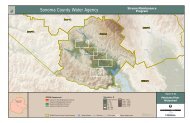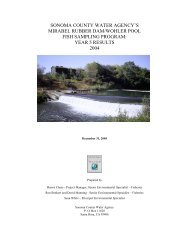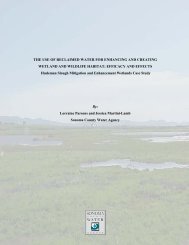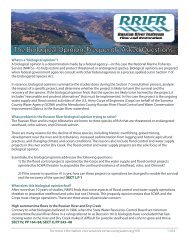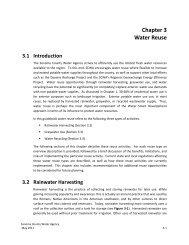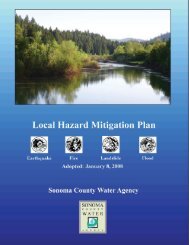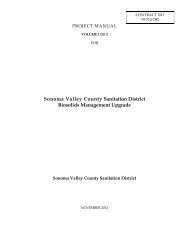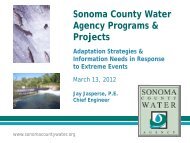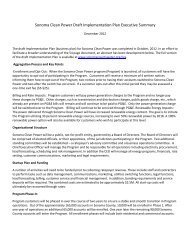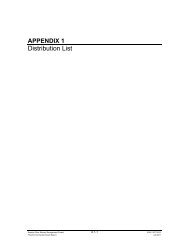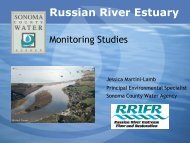Hydrography of the Russian River Estuary - Sonoma County Water ...
Hydrography of the Russian River Estuary - Sonoma County Water ...
Hydrography of the Russian River Estuary - Sonoma County Water ...
Create successful ePaper yourself
Turn your PDF publications into a flip-book with our unique Google optimized e-Paper software.
• Instrument precision<br />
The error associated with each <strong>of</strong> <strong>the</strong>se terms is quantified for different inlet conditions,<br />
taking a worst-case scenario (i.e., conditions that would produce <strong>the</strong> worst possible<br />
error). Thus, this error analysis does not quantify actual error but ra<strong>the</strong>r seeks an upper<br />
bound to <strong>the</strong> possible error in calculating salt and oxygen masses.<br />
Section uniformity errors – The vertical distribution <strong>of</strong> salinity and dissolved oxygen in<br />
<strong>the</strong> water column is not entirely uniform throughout <strong>the</strong> estuary, even during closure.<br />
CTD pr<strong>of</strong>iles taken at <strong>the</strong> locations shown in Figure 2.1 may not be representative <strong>of</strong> <strong>the</strong><br />
average vertical pr<strong>of</strong>ile in each segment <strong>of</strong> <strong>the</strong> estuary. A fully accurate budget would<br />
require CTD pr<strong>of</strong>iles at many locations within each segment <strong>of</strong> <strong>the</strong> estuary, which is not<br />
feasible. The segmentation <strong>of</strong> <strong>the</strong> estuary shown in Figure 3.37 was chosen to provide<br />
reasonable accuracy while balancing time constraints. To obtain a quantitative estimate<br />
<strong>of</strong> <strong>the</strong> errors that this simplification creates, <strong>the</strong> pr<strong>of</strong>ile in <strong>the</strong> segment was compared<br />
with <strong>the</strong> average <strong>of</strong> <strong>the</strong> pr<strong>of</strong>iles from <strong>the</strong> 2 adjacent segments. Tables 3.2 and 3.3 show<br />
that <strong>the</strong> total masses obtained using <strong>the</strong>se average pr<strong>of</strong>iles differ from those from <strong>the</strong><br />
actual CTD pr<strong>of</strong>iles by 1.0-8.1 percent for salt and 0.9-6.9 percent for dissolved oxygen.<br />
Elevation estimate errors – Since water level elevations were normalized to <strong>the</strong> Jenner<br />
gage, ra<strong>the</strong>r than tied to known coordinates using survey equipment, reported water<br />
levels may be inaccurate by several centimeters (see discussion in Section 2).<br />
Inaccuracies in water level cause misalignments between <strong>the</strong> stage-storage curve for<br />
each segment <strong>of</strong> <strong>the</strong> estuary and <strong>the</strong> corresponding CTD pr<strong>of</strong>iles. Assuming that water<br />
level estimates are accurate to within ± 5cm, <strong>the</strong>se errors are below 3%, regardless <strong>of</strong><br />
inlet condition (Tables 3.2 and 3.3).<br />
Pycnocline tilt errors – During high wind conditions, <strong>the</strong> surface <strong>of</strong> <strong>the</strong> estuary was<br />
observed to tilt by as much as 5cm in <strong>the</strong> upstream direction. A corresponding tilt (in <strong>the</strong><br />
reverse direction) <strong>of</strong> <strong>the</strong> subsurface pycnocline is expected to be much larger and it<br />
would temporarily make <strong>the</strong> outer estuary saltier and <strong>the</strong> inner estuary fresher. Errors<br />
would arise if <strong>the</strong> tilt is non-uniform, or if <strong>the</strong> number <strong>of</strong> pr<strong>of</strong>iling locations is insufficient<br />
to determine its shape. The order <strong>of</strong> <strong>the</strong>se errors was obtained by comparing masses<br />
estimated with a tilted pycnocline to those estimated during low-wind conditions. The<br />
maximum water surface tilt observed during CTD measurements was 2cm, which would<br />
result in a tilt <strong>of</strong> <strong>the</strong> pycnocline <strong>of</strong> about 0.8 meters (2.6 feet), estimated from <strong>the</strong> ratio<br />
between ρ and Δρ (Fischer et al. 1979). Errors for both total estuary salt and oxygen<br />
mass are below 7%, and are highest for most strongly stratified conditions (Tables 3.2<br />
and 3.3). Most CTD measurements were taken during low wind conditions, so <strong>the</strong>se<br />
results are intended to illustrate <strong>the</strong> maximum possible error observed in <strong>the</strong> data.<br />
64





